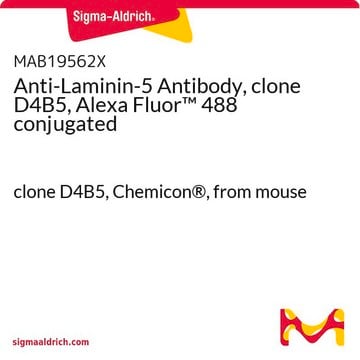Recommended Products
biological source
sheep
Quality Level
antibody form
serum
antibody product type
primary antibodies
clone
polyclonal
species reactivity
mouse, human, rat
manufacturer/tradename
Chemicon®
technique(s)
immunocytochemistry: suitable
immunohistochemistry: suitable
western blot: suitable
NCBI accession no.
UniProt accession no.
shipped in
wet ice
target post-translational modification
unmodified
Gene Information
human ... ACTG1(71)
General description
Actin is a 43kDa highly conserved structural protein. There are three main actin isotypes (alpha,beta and gamma) which show >90% amino-acid (aa) homology between isotypes and >98% homology within members of a particular isotypic group. The majority of the isotype heterogeneity is located in the amino-terminal 30 aa. The different actin isotypes have been shown to behave very differently in vitro and in vivo. Recent studies describe differential subcellular localization of gamma-actin and isotype specific binding of actin associated proteins. {Pardo et al, 1983, Cell 32:1093-1103 & Otey, CA et al 1986 J Cell Biol 102:1726-1737, Bassell et al, 1998, J Neurosci 18:251-265 {available online}. Furthermore, there are at least six actin isoforms in vertebrates: cardiac alpha-actin and skeletal-alpha actin (expressed in striated muscle), vascular alpha-actin and enteric gamma-actin (expressed in smooth muscle), and cytoplasmic beta- and gamma-actins.{http://www.cbil.upenn.edu/MTIR/gammaActin_E-toc.html}
Specificity
Recognizes actin, gamma. Specificity for gamma actin determined by 2D gel electrophoresis.
Immunogen
Epitope: gamma
Synthetic peptide corresponding to the amino terminus of gamma actin {EEEIAALVIDNGSGGSG} conjugated to KLH.
Application
Anti-Actin Antibody, γ is an antibody against Actin for use in IC, IH & WB.
Research Category
Cell Structure
Cell Structure
Research Sub Category
Cytoskeleton
Cytoskeleton
Western Blot: 1:500-1:2,000 or greater; non-specific bands can occur when primary antibody is overloaded. Blocking with purified milk proteins preferred over commerical concentrated milk solutions. Detects a 42-43kDa band. Specificity for gamma actin determined by 2D gel electrophoresis.
Immunocytochemistry: 1:500-1:2,000. Cultured cells fixed with PFA, then permeabilized with methanol.
Immunohistochemistry: 1:500-1:2,000. Tissues frozen and then fixed with PFA followed by Triton permeabilisation. 10% buffered formalin fixed tissues have also been used.
Optimal working dilutions must be determined by the end user.
Immunocytochemistry: 1:500-1:2,000. Cultured cells fixed with PFA, then permeabilized with methanol.
Immunohistochemistry: 1:500-1:2,000. Tissues frozen and then fixed with PFA followed by Triton permeabilisation. 10% buffered formalin fixed tissues have also been used.
Optimal working dilutions must be determined by the end user.
Target description
42-43kDa
Physical form
Serum. Liquid, containing no preservatives.
Unpurified
Storage and Stability
Maintain for 1 year at -20°C from date of shipment. Aliquot to avoid repeated freezing and thawing. For maximum recovery of product, centrifuge the original vial after thawing and prior to removing the cap.
Analysis Note
Control
Smooth muscle
Smooth muscle
Other Notes
Concentration: Please refer to the Certificate of Analysis for the lot-specific concentration.
Legal Information
CHEMICON is a registered trademark of Merck KGaA, Darmstadt, Germany
Disclaimer
Unless otherwise stated in our catalog or other company documentation accompanying the product(s), our products are intended for research use only and are not to be used for any other purpose, which includes but is not limited to, unauthorized commercial uses, in vitro diagnostic uses, ex vivo or in vivo therapeutic uses or any type of consumption or application to humans or animals.
Not finding the right product?
Try our Product Selector Tool.
recommended
Product No.
Description
Pricing
Storage Class Code
10 - Combustible liquids
Certificates of Analysis (COA)
Search for Certificates of Analysis (COA) by entering the products Lot/Batch Number. Lot and Batch Numbers can be found on a product’s label following the words ‘Lot’ or ‘Batch’.
Already Own This Product?
Find documentation for the products that you have recently purchased in the Document Library.
Zengdun Shi et al.
Laboratory investigation; a journal of technical methods and pathology, 97(12), 1412-1426 (2017-10-17)
Liver fibrosis, a model wound healing system, is characterized by excessive deposition of extracellular matrix (ECM) in the liver. Although many fibrogenic cell types may express ECM, the hepatic stellate cell (HSC) is currently considered to be the major effector.
Don C Rockey et al.
The American journal of pathology, 189(11), 2209-2220 (2019-09-03)
In the liver, smooth muscle α-actin (SM α-actin) is up-regulated in hepatic stellate cells (HSCs) as they transition to myofibroblasts during liver injury and the wound healing response. Whether SM α-actin has specific functional effects on cellular effectors of fibrosis
Chandrashekara Kyathanahalli et al.
Proceedings of the National Academy of Sciences of the United States of America, 112(45), 14090-14095 (2015-10-28)
We previously identified myometrial caspase-3 (CASP3) as a potential regulator of uterine quiescence. We also determined that during pregnancy, the functional activation of uterine CASP3 is likely governed by an integrated endoplasmic reticulum stress response (ERSR) and is consequently limited
S D Burton et al.
Neuroscience, 215, 1-16 (2012-05-01)
Neuroligins are a family of cell adhesion molecules critical in establishing proper central nervous system connectivity; disruption of neuroligin signaling in vivo precipitates a broad range of cognitive deficits. Despite considerable recent progress, the specific synaptic function of neuroligin-1 (NL1)
Roberta Cagnetta et al.
Neuron, 99(1), 29-46 (2018-07-17)
Axonal protein synthesis and degradation are rapidly regulated by extrinsic signals during neural wiring, but the full landscape of proteomic changes remains unknown due to limitations in axon sampling and sensitivity. By combining pulsed stable isotope labeling of amino acids
Our team of scientists has experience in all areas of research including Life Science, Material Science, Chemical Synthesis, Chromatography, Analytical and many others.
Contact Technical Service





